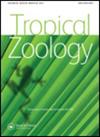寄主密度对小蜂1836生命表统计的影响(膜翅目:小蜂科)
IF 0.7
4区 生物学
Q4 ZOOLOGY
引用次数: 9
摘要
小檗具有较高的繁殖力和自然增殖率,是对付常见储粮害虫头蚜的理想天敌。寄生蜂的功能反应可以决定一个物种作为生物防治剂的潜力;它定义了寄生蜂的搜索效率,并提供了对寄主-寄生蜂相互作用的理解。在不同寄主密度下,雌性寄生蜂的平均寿命无显著差异。不同寄主密度对其成虫性别比有显著影响。净繁殖率(R0)和总繁殖率(Rt)在寄主密度为5只/生殖室时最高。寄主密度1的平均世代时间(T.c)高于其他密度;当寄主密度为5时,内在增长率最高,当寄主密度为20时,内在增长率最低。其他生命表参数也受到显著影响。在生命表统计的基础上,我们可以说这种密度响应行为可以被认为是最稳定的一种。本文章由计算机程序翻译,如有差异,请以英文原文为准。
Effect of host density on life table statistics of Bracon hebetor Say, 1836 (Hymenoptera: Braconidae)
Bracon hebetor Say shows high fecundity and natural rate of increase which makes it a promising enemy against Corcyra cephalonica, a very common stored grain pest. The functional response of the parasitoid can determine potential of a species to act as a biocontrol agent; it defines parasitoid’s searching efficiency and provides an understanding of host–parasitoid interaction. The mean longevity of female parasitoids had no significant difference when maintained at different densities of host insects. However, progeny sex ratio was significantly affected when different host densities were maintained during its adult life. The net fecundity rate (R0) and total fecundity rate (Rt) were highest when host density was five hosts per reproductive chamber. The mean length of generation time (T.c.) was higher on host density one compared to other densities. The intrinsic rate of increase (rm) was highest when the host density was five and lowest on 20 hosts per reproductive chamber. Other life table parameters were also affected significantly. On the basis of life table statistics, we can say that this type of density-responsive behaviour can be considered to be the most stabilizing one.
求助全文
通过发布文献求助,成功后即可免费获取论文全文。
去求助
来源期刊

Tropical Zoology
生物-动物学
CiteScore
2.50
自引率
0.00%
发文量
1
审稿时长
>12 weeks
期刊介绍:
Tropical Zoology is an international zoological journal publishing original papers in the field of systematics, biogeography, phylogeny, ecology and conservation of all terrestrial and aquatic animal Phyla from tropical and subtropical areas.
Only papers with new information, high quality and broad interest are considered. Single species description and checklists are not normally accepted. Review papers are welcome. The journal is owned by the Istituto di Ricerca sugli Ecosistemi Terrestri of the Consiglio Nazionale delle Ricerche, Florence, Italy (CNR-IRET) who performs research into the structure and functioning of aquatic and terrestrial ecosystems, focusing in particular on anthropogenic pressure and global change. The knowledge amassed forms the scientific basis for identifying the most appropriate protective and corrective interventions, and provides support for the bodies entrusted with formulating policies for environmental protection and recovery.
 求助内容:
求助内容: 应助结果提醒方式:
应助结果提醒方式:


